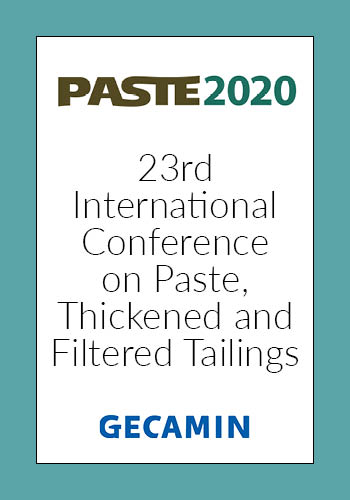An Experimental Study on the Hindered Settling Properties of Backfill Tailings Particles

|
Authors: Peng, X; Yang, X; Guo, L |
DOI https://doi.org/10.36487/ACG_repo/2052_05
Cite As:
Peng, X, Yang, X & Guo, L 2020, 'An Experimental Study on the Hindered Settling Properties of Backfill Tailings Particles ', in H Quelopana (ed.), Paste 2020: 23rd International Conference on Paste, Thickened and Filtered Tailings, Gecamin Publications, Santiago, https://doi.org/10.36487/ACG_repo/2052_05
Abstract:
Mining using backfill methods has been utilized by many mines around the world. Tailings thickening, one of the ways to prepare backfill materials, has been studied worldwide and components of the process such as the thickening mechanism of the tailings tank and principles of selecting flocculants have already been worked out. The studies of hindered settling properties of tailings during this process have lagged which can restrict the precise control of tailings thickening and affect the backfill result. Using in-situ tailings from a mine, hindered and polydisperse settling experiments of tailing slurries with different concentrations and different particle size distributions have been launched to study and analyze the hindered settling features of tailing particles. The experimental results show that the R-square figure of the hindered settling rates of classified tailings between calculated values based on Richardson-Zaki model and experimental ones is over 0.87 proving the Richardson-Zaki model can be used to calculate and predict the hindered settling rates of classified tailings. Moreover, Selim’s theory can capture the main properties of the polydisperse settling process of the mix of sieved and silica tailings. The self-flocculation of fine particles in silica tailings has increased the “hindering effect” among particles, the experimental settling rates of silica tailings are less than those theoretical values calculated by Selim theory.
References:
Alam, N., Ozdemir, O., Hampton, M.A. & Nguyen, A.V., (2011). ‘Dewatering of coal plant tailings: Flocculation followed by filtration. ‘ Fuel, 90(1), 26-35.
Botha, L. & Soares, J.B., (2015). ‘The influence of tailings composition on flocculation. ‘The Canadian Journal of Chemical Engineering, 93(9), 1514-1523.
Chalaturnyk, R. J., Don Scott, J. & Özüm, B. (2002). ‘Management of oil sands tailings.‘ Petroleum Science and Technology, 20(9-10), 1025-1046.
Davis, R. H. & Gecol, H. (1994). ‘Hindered settling function with no empirical parameters for polydisperse suspensions.’ AIChE journal, 40(3), 570-575.
Kynch, G. J. (1952). ‘A theory of sedimentation.‘ Transactions of the Faraday Society, 48(2), 166-176.
Mehta, A. J. (1994). ‘Problems in Linking the Threshold Condition for the Transport of Cohesionless and Cohesive Sediment Grain.’ Journal of Coastal Research, 10(1), 170-177.
Richardson, J. F. & Zaki, W N. (1954). ‘Sedimentation and fluidization: Part I. ‘ Transactions of the Institution of Chemical Engineers. 32, 35.
Selim, M. S., Kothari, A. C. & Turian, R. M. (1983). ‘Sedimentation of multisized particles in concentrated suspensions.’ AIChE journal, 29(6), 1029-1038.
Yang, X. C., Guo, L. J., Xu, W. Y., et al. (2018). Comprehensive Utilization Technology of Tailings and Waste Rocks, Chemical Industry Press, Beijing.
© Copyright 2026, Australian Centre for Geomechanics (ACG), The University of Western Australia. All rights reserved.
View copyright/legal information
Please direct any queries or error reports to repository-acg@uwa.edu.au
View copyright/legal information
Please direct any queries or error reports to repository-acg@uwa.edu.au